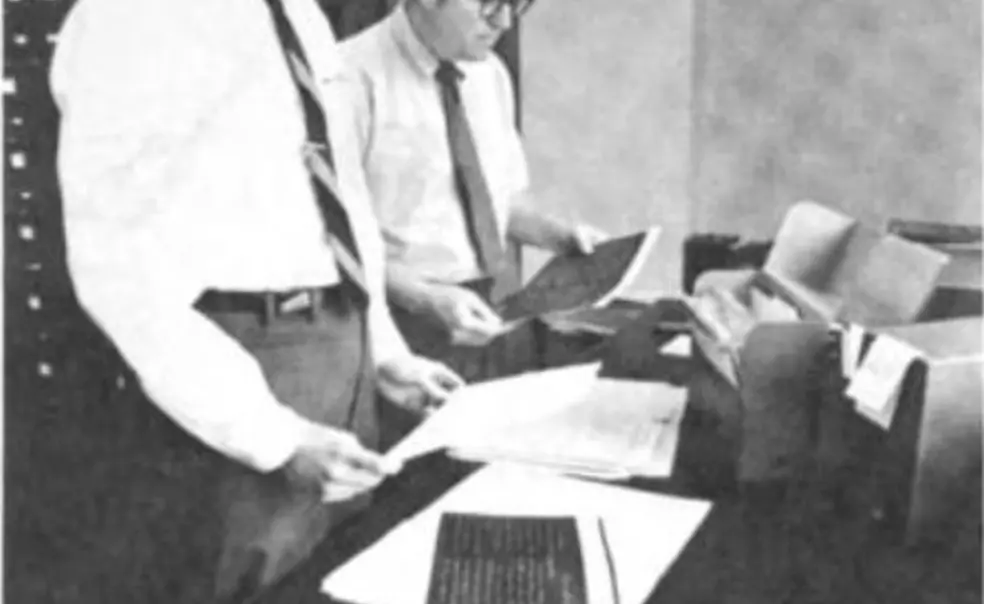The Papers of Woodrow Wilson ’79
A scholarly enterprise of unusual magnitude just keeps rolling along...
Howard Segal is a graduate student in history who says that he is “unfailingly awestruck every time I contemplate the vast diligence and resourcefulness that has gone into the task of organizing Woodrow Wilson’s life and thoughts through his personal and public papers.” – Editor (1971)
It should surprise no one familiar with Princeton to learn that within a cluttered, rabbit-warren of offices in Firestone Library there presently continues a scholarly enterprise of extraordinary national as well as local interest. Surrounded by filing cabinets and stacks of notes and letters, a small band of scholars and researchers are steadily moving through their thirteenth year of work on a monumental task: the editing of the papers of Woodrow Wilson.
Thus far, the editors have turned out eleven volumes of Wilson’s papers, taking his life up to his day as a Princeton professor. It is expected that the complete set, which is being published by Princeton University Press, will number as many as 40 or 45 volumes. Although that may seem a formidable number, it is not exceptionally large in comparison to other editions of presidential papers being prepared at Princeton and other universities. The papers of Thomas Jefferson, also published by Princeton University Press, are now in the seventeenth volume and should easily reach 50 volumes or more.
The man in charge of the Wilson papers probably knows more than anyone else about the Princeton professor who became the 28th president of the United States. He is Dr. Arthur S. Link, Edwards Professor of History, who has been a figure of considerable stature on the Princeton faculty ever since he arrived here in 1960. Professor Link, a patient and gracious man who is often seen with a pipe, has been joined on the Wilson project by two associate editors: Dr. David W. Hirst and Dr. John E. Little. Until he retired last June, Dr. John Wells Davidson was Senior Research Historian and Associate Editor and played a major role in the gathering and cataloging of thousands of papers in the Library of Congress and elsewhere that became the raw material for the published Wilson papers.
No one individual or group can claim sole credit for the decision to go ahead and publish Woodrow Wilson’s papers. It is clear, however, that the idea itself grew out of the 1956 Wilson centennial year celebration, which demonstrated the need to re-think traditional assumptions about the man and his contributions to American life. As part of that commemoration, Dr. Hirst conducted a survey for the celebration commission. The survey revealed that, on one hand, Wilson’s letters were widely scattered but that, on the other, a large quantity of materials had become available since the publication of Ray Stannard Baker’s authorized biography in 1939.
Hirst’s report was turned over to the Woodrow Wilson Foundation, a private organization established in 1922 to disseminate throughout America the ideals for which its namesake lived. The foundation in turn named its own committee to investigate the problems involved in publication. Many of those problems were resolved in February, 1958, with the appointment of Dr. Link, then professor of history at Northwestern University and already recognized as the nation’s leading Wilson scholar, as editor (and subsequently as a professor of history at Princeton). Other problems were resolved a year later, with the co-sponsorship of the entire project by the foundation and Princeton.
This is not to suggest that until then the documents comprising the Wilson papers had simply been accumulating dust, for the bulk of materials had already been collected in several depositories in Washington, D. C. Moreover, as the editors acknowledged in their general introduction, “Wilson himself made the single greatest contribution to the preservation of his papers” by saving most of his various writings – his books, essays, articles, speeches, scrapbooks, notebooks, and so on – from 1874 until his death half a century later. The major exception was his own letters, copies of which he did not consistently keep until the early 1900s. Finally, a number of collections containing selected documents had appeared long before 1958, though none was definitive, due in part to Mrs. Wilson’s understandable reluctance to allow widespread publication of the more personal items, a reluctance she overcame with the start of the present project.
Approval and funding did not, of course, lead to immediate publication. The editors were confronted with the problem of gathering, cataloging, and copying literally hundreds of thousands of documents. After Dr. Link left for England to fulfill his year-long obligation as Oxford University’s Harmsworth Professor of American History in September of 1958, Dr. Davidson and, a year later, Dr. Hirst began the job by hiring some 25 researchers, typists, and secretaries. This part of the editorial process took five years to complete and required extensive researches in hundreds of libraries throughout the country. The burdens entailed were nevertheless made immeasurably lighter by the timely manufacture of the earliest Xerox machines available for commercial use, of which several had been purchased by the Library of Congress, the project’s headquarters during those years. “The fruit of this labor,” the general introduction concludes, “is the collection of photocopies, typescripts, shorthand transcripts, and additional papers” filling 19 large cabinets in Firestone Library, to which hundreds of other documents have been added since 1963, when the editors moved their enterprise to the campus. It should be noted that while the Library of Congress, as the primary repository for official government papers, contains the largest number of documents pertaining to Wilson’s years in public service, the editors have now made Firestone the largest repository of materials pertaining to Wilson’s life in general and to the lives of his associates and contemporaries as well.
It is worth asking what motivates a group of first-rate scholars – for all four primary editors had already given substantial evidence of their overall scholarly abilities in books and articles not only on Wilson but on other aspects of American history as well – to dedicate a good portion of their lives to such an obviously arduous and, at times, tedious task. The answer is that there apparently exists a consensus among the editors that Woodrow Wilson as a human being, and not simply as president of either Princeton or the United States or even both, was an extraordinarily brilliant and complex figure whose life and times deserve sustained examination. In this respect, the papers will ultimately become the truly definitive biography, a biography no conventional writer could ever hope to emulate.
This comprehensive approach, not surprisingly, has been carried over into the editorial process itself. The editors recognized at the outset not only the impracticality but also the irrelevance (to historical scholarship) of publishing every single document by or relating to Woodrow Wilson. They agreed instead to reproduce “only” those papers illuminating their subject’s life and the lives of his associates, thereby necessitating the most sophisticated editorial judgments. The final result will be some 40 to 45 volumes, each centered upon a particular stage in Wilson’s physical, psychological, and intellectual development; e.g., his years as university president will comprise several volumes, with one devoted to the emergence of his educational philosophy, the rest to its application.
Interestingly, not one of the original editors came to the project with the kind of background one might assume all would already have acquired. Instead, all the editors were novices, learning as much as they could about editorial procedures from others in the field – including, among others, Princeton’s own Julian P. Boyd, the distinguished historian and current editor of the Thomas Jefferson papers. In this light, it is all the more remarkable that the editors have not only produced such universally acclaimed volumes but also that they have also had virtually no disagreements among themselves over either procedures or selection of materials, a fact that says a great deal about their collective insight into Woodrow Wilson’s world.
The initial volume, covering the years between birth in 1856 and withdrawal from the University of Virginia in 1880, took a year to complete, appearing at last in 1966. Later volumes have generally required five or six months’ work apiece; they have been published at the rate of two per year, a rate the editors hope to maintain until completion of the entire project. As of this writing, eleven volumes have appeared, with Volume XII scheduled for March publication, to be followed by another volume comprising a complete index to the previous twelve. (The index, it should be pointed out, will be the first to enable scholars to trace the many and divergent strands of Wilson’s thought from childhood until his acceptance of the presidency of Princeton.)
Once the documents for a particular volume have been collected and the publication date set, the editors must then set about arranging, annotating, and, perhaps most importantly, checking and rechecking their selections for accuracy. They normally consult five major files: correspondence, speeches, literary (writing), shorthand (primarily drafts of writings), and diaries (and diary-like materials such as jottings, notations, lecture outlines). Whatever is known to be missing is then tracked down with uncommon zeal and, incidentally, uncommon success: approximately 80 percent of Wilson’s hitherto scattered personal correspondences have now been collected, though additional contributions are naturally always welcome. While the letters are obviously revealing of Wilson’s personal life, Dr. Link observes that Wilson used major speeches rather than private letters to articulate changes in his public policies.
The documents selected for probably publication are then typed up on loose-leaf paper and placed in several large binders. The arrangement, as noted, is topical. Annotation, which follows, consumes three or four months’ work from both Dr. Hirst and Dr. Little and is followed by Dr. Link’s own month of further checking and further writing. Submission of a particular manuscript to Princeton University Press by no means terminates editorial responsibility, for both galley and page proofs must also be scrutinized for possible errors, of which, through the first eleven volumes, there have been only three or four minor ones.
The time between inception of a specific volume and its actual publication is usually a mere year and a half, a considerable feat in itself. Should additional documents relating to a previously published volume turn up later, those documents, if deemed sufficiently significant by the editors, are simply appended to a succeeding one. Nevertheless, the cumulative index – skillfully compiled by Mr. M. Halsey Thomas, University Archivist, Emeritus – will include all materials in their proper order.
And so the editors of the Woodrow Wilson Papers diligently pursue their chosen lifelong task, admittedly content with the knowledge that, as Dr. Link put it, long after the more conventional biographies and histories of the man and the period have been written and virtually forgotten – though Dr. Link is much too modest about his own study, the last three volumes of which he hopes to complete after publication of the entire papers series – this collection of documents and of notes, superbly illuminating the complexities of one of America’s most important citizens, will endure.
This was originally published in the November 16, 1971 issue of PAW.











No responses yet